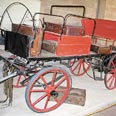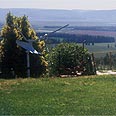

KIBBUTZ YIFAT - The Pioneer Settlement Museum is tucked away in the Western part of the Jezreel Valley in Kibbutz Yifat, not far from Moshav Nahlal. It is a testament to the settlers of the Second and Third Aliyah - the immigrants who came to Israel between 1882 and 1914.
Open since 1972, the museum provides a wonderful, varied glimpse into what rural life must have been like for the pioneers, or, as they are known in Hebrew, “Halutzim.”
They dried the swamps, dug ditches, worked as stone-cutters, built roads, and laid the foundation for what would later become Israel's world renowned agricultural accomplishments. Their days were, for the most part, filled with hard physical labor to which most of them were not accustomed. But they persevered.
The pioneers of the Second Aliyah had significant impact on the newly developing land. They came primarily in the wake of the pogroms in Russia. They established the first kibbutz, Degania, revived the Hebrew language, laid the foundations for Tel Aviv and created the first Jewish defense organization, Ha'Shomer.
The immigrants of the Third Aliyah came primarily from Eastern Europe. They created the Histadrut - the General Federation of Labor – and drained the swamps of the Jezreel Valley and the Hefer Plain. They also established the Haganah, a clandestine Jewish defense organization which operated during the days of the British Mandate.
Driving force
The driving force for these pioneers' decision to make their home in Israel came as a result of the October Revolution in Russia and the increasing number of pogroms in nearby countries such as Hungary and Poland.
Before they had sheds, the pioneers lived in tents. The tents did not afford much room for privacy and were often inhabited by three people, a couple and a single person. The third person was often referred to as the “primus”. While the exact nature of this expression isn't completely certain there is one assertion that it may be symbolic of the three legs that typified the small stoves of the day, which were called “primus”.
At the museum at Kibbutz Yifat you'll be able to see a common shed dwelling, from a Moshav. In addition, you can enter the small dining room, full of interesting knick-knacks. The Pioneer Settlement Museum also features the famous “communal shower” of days gone by, the communal clothing storage area, a typical infirmary, and the first oil-generated water pump that was imported from Germany at the end of the 1920's.
There is also a large collection of farm equipment, older wooden farm implements as well as more modern farming machines.
Anyone with an interest in the early days of the modern settlement of Israel is bound to enjoy a visit to this museum – which provides rich historical anecdotes. Throughout the exhibits you'll find large signs in English that provide ample explanations in a clear and concise manner.
Directions: The Pioneer Settlement Museum is located at Kibbutz Yifat, off Route # 73 (not far from Migdal Ha'emek).
Reprinted with permission from Gems in Israel, a Travel and Events in Israel Web site.















